In travelling from Toledo to Segovia we detoured via the enormous monastery/royal palace of El Escorial. Originally set in an isolated woodland setting, the monks were supposed to pray for the souls of the kings. But it was also a good place for hunting and maybe a royal residence, so this absolutely monumentally huge building was created, surrounded by paved forecourts, Italianate gardens and walled forests.
 El Escorial | 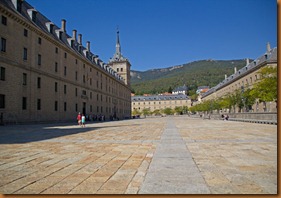 The modest forecourt |  The church, based on St Peters |
It was built of granite and is probably the most solid, cold, enormous and absolutely unappealing building we have visited. Photos were not allowed inside, so only a few of the forecourt here. We were glad to leave and have a rather nice lunch of Iberian cold meats before moving on through the sweeps of farm land to Segovia itself, the city high on the hill before us.
 Farming lands |  Cityscape and walls | 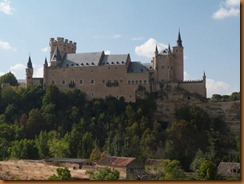 The Alcazar from the valley below |
This is a city absolutely dominated by one major feature; a perfect Roman aqueduct that runs right through the centre, built about 2000 years ago without mortar, and intact because it still supplies the city with water (sources differ on this, it may have recently ceased being used).
 Aqueduct continuing to the distance | 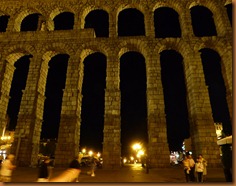 Aqueduct and square at night | 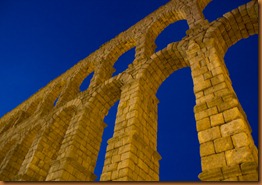 In the early evening |
To add to the sights, there is a fairy-tale castle, the Alcazar, complete with conical slate rooves, at one end of town and a very impressive cathedral atop the hill. Very sensibly, a great deal of the old town is closed to vehicular traffic and streets are filled with cafes and shops and crowds of people, especially in the early evening, for the Spanish equivalent of the passegiata. We were only too happy to join in.
Because of the road closures we had some difficulty in finding the way to our hotel, and while I looked for the tourist office, Nick parked almost under the aqueduct. The friendly motorcycle policeman was happy to tell us which way to take; basically back through the green valley below the walls, up past the Alcazar and through a warren of one way streets to our palace/hotel. Well it sounds grand, and it truly was a palace, but it is a small hotel now, the sort that turns off the hot water in the day and provides only a very basic breakfast. But clean and convenient.
Segovia is quite hilly, so to get to the Plaza Major without climbing hundreds of stairs one must walk in the opposite direction, along a very pleasant, wide pedestrian street, through the aqueduct square and then up a long and gently sloping main street. On the trip we passed a number of quite ancient churches, mainly 12th century, including St Millan and St Martin, and a fabulous old palatio covered with granite points. In the valley around are more very old churches and walled monasteries. It is difficult to get our minds around the idea of a city that existed pre the Christian era and which has architecture dating back so far.
 San Millan | 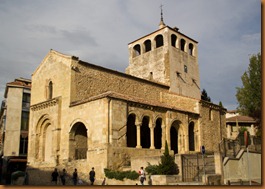 San Clemente | 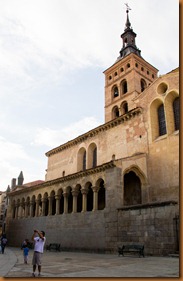 San Martin |
After exploring the first evening, and eating in a lovely outdoor setting on the main street with a view over the rooftops, we began the next day by gently climbing back up the street, past the cathedral and on to the Alcazar. Now truth is, this looks a bit like the first Disney castle, which might be explained by the story that it was the inspiration for Disney. Who knows? The Alcazar was badly burned at one stage in the 18th century, and greatly restored. Because the decorations had been accurately recorded on order of a king, they were able to replace almost all the ceilings, carvings and friezes. Magnificent!
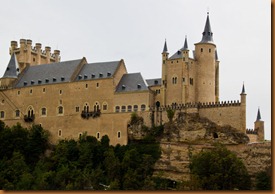 The Alcazar | 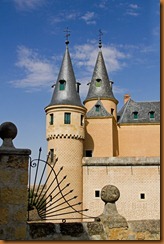 Fairytale turrets | 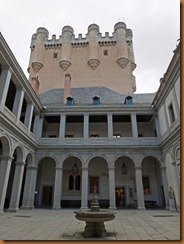 Alcazar courtyard |
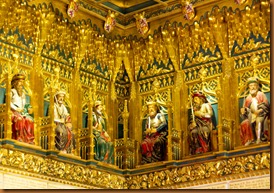 Freize of all the kings of Spain |  Amazing ceiling | 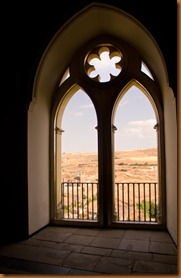 Window with view to the valley |
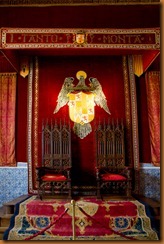 Royal thrones |  Amazingly weird lamp post outside the Alcazar |
The cathedral is huge and relatively light filled. Like many Spanish cathedrals, the main altar is closed off with an ornate grille, as is the choir, leaving little room for the hoi-polloi to actually see the mass. Nevertheless, very beautiful and with a lovely cloister.
Outside the town we attempted to visit the Church of Vera Cruze (the true cross) but it was closed and the same can be said for several of the older churches in the town. We did get to see inside St Millan, one of the oldest, but mass was about to start and taking photos was not appropriate. Beautiful Romanesque arches and apses and a very old crucifix gave it a deep spirituality. You could see why people were drawn to worship there.
Vera Cruz outside the walls
There are other pretty features of the town such as lovely palaces and windows. Lunch in the light filled Plaza Major was very leisurely; beer and a tomato and anchovy sandwich. We also saw a wedding party as they left the town hall to resounding cheers and whistles, all the guests dressed in their best finery. A very liveable town, full of people who knew each other and delighted in each other’s company, from babies to elders.
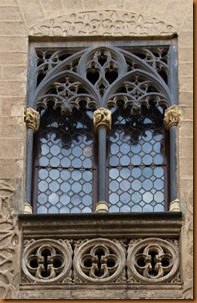 Gorgeous window | 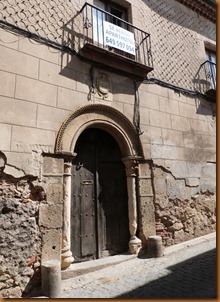 Slightly in need of TLC and for sale |  This life is good! |
Next stop: Salamanca
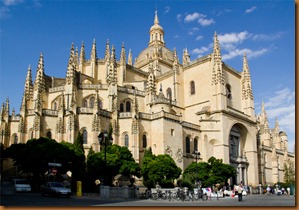
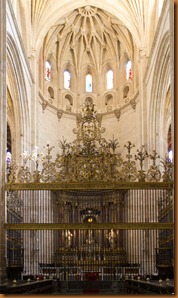

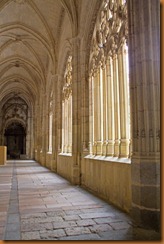

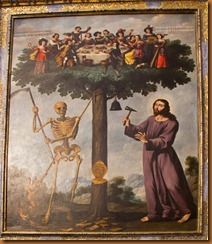

No comments:
Post a Comment